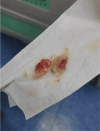First aid treatment and airway management for chemical burns combined with inhalation injury: A case report
- PMID: 39703676
- PMCID: PMC11655304
- DOI: 10.1002/rcr2.70094
First aid treatment and airway management for chemical burns combined with inhalation injury: A case report
Abstract
Chemical burns account for a small percentage of burn patients, and there are even fewer burn patients suffering from chemical burns combined with inhalation injury. As chemical substances corrode the airway, which leads to persistent necrotic shedding of the respiratory mucosa and scarring contracture as the airway heals, a proportion of patients develop airway stenosis, requiring more aggressive treatment or even surgery. A 38-year-old female chemical factory worker sustained an inhalation injury due to exposure to reactive substances (liquid and smoke) during production. She developed third- to fourth-grade airway stenosis and dyspnoea 2 months postinjury. Interhospital consultation led to referral to the Second Affiliated Hospital of Xi'an Jiaotong University for tracheotomy and endotracheal stent implantation. Postoperative dyspnoea improved, and regular follow-up was performed. The treatment process of this patient has provided us with valuable experience in the initial management and respiratory tract care of chemical burn patients.
Keywords: airway management; airway obstruction; burns; case report; inhalation; tracheotomy.
© 2024 The Author(s). Respirology Case Reports published by John Wiley & Sons Australia, Ltd on behalf of The Asian Pacific Society of Respirology.
Conflict of interest statement
None declared.
Figures




Similar articles
-
[Epidemiological characteristics and outcome analysis of 266 patients with inhalation injuries combined with total burn area less than 30% total body surface area].Zhonghua Shao Shang Za Zhi. 2021 Apr 20;37(4):340-349. doi: 10.3760/cma.j.cn501120-20200229-00106. Zhonghua Shao Shang Za Zhi. 2021. PMID: 33887882 Free PMC article. Chinese.
-
[Analysis on treatment of extremely severe burn patients with severe inhalation injury in August 2nd Kunshan factory aluminum dust explosion accident].Zhonghua Shao Shang Za Zhi. 2018 Jul 20;34(7):455-458. doi: 10.3760/cma.j.issn.1009-2587.2018.07.007. Zhonghua Shao Shang Za Zhi. 2018. PMID: 30060347 Chinese.
-
[Analysis on treatment of eight extremely severe burn patients in August 2nd Kunshan factory aluminum dust explosion accident].Zhonghua Shao Shang Za Zhi. 2018 Jun 20;34(6):332-338. doi: 10.3760/cma.j.issn.1009-2587.2018.06.004. Zhonghua Shao Shang Za Zhi. 2018. PMID: 29961288 Chinese.
-
Smoke inhalation: diagnosis and treatment.World J Surg. 1992 Jan-Feb;16(1):24-9. doi: 10.1007/BF02067110. World J Surg. 1992. PMID: 1290262 Review.
-
Revisiting extracorporeal membrane oxygenation for ARDS in burns: A case series and review of the literature.Burns. 2018 Sep;44(6):1433-1438. doi: 10.1016/j.burns.2018.05.008. Epub 2018 Jun 11. Burns. 2018. PMID: 29903600 Review.
References
LinkOut - more resources
Full Text Sources
Research Materials

